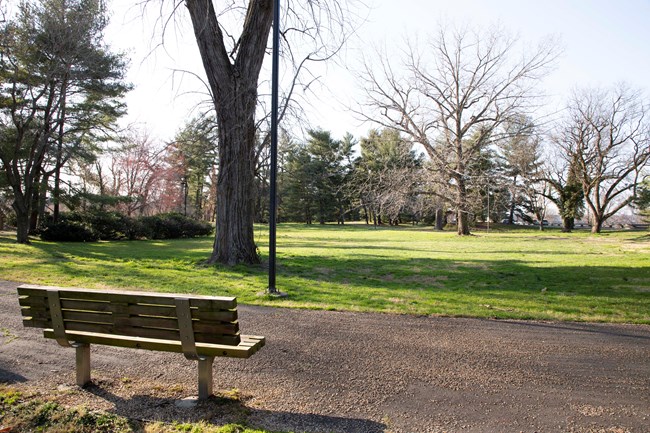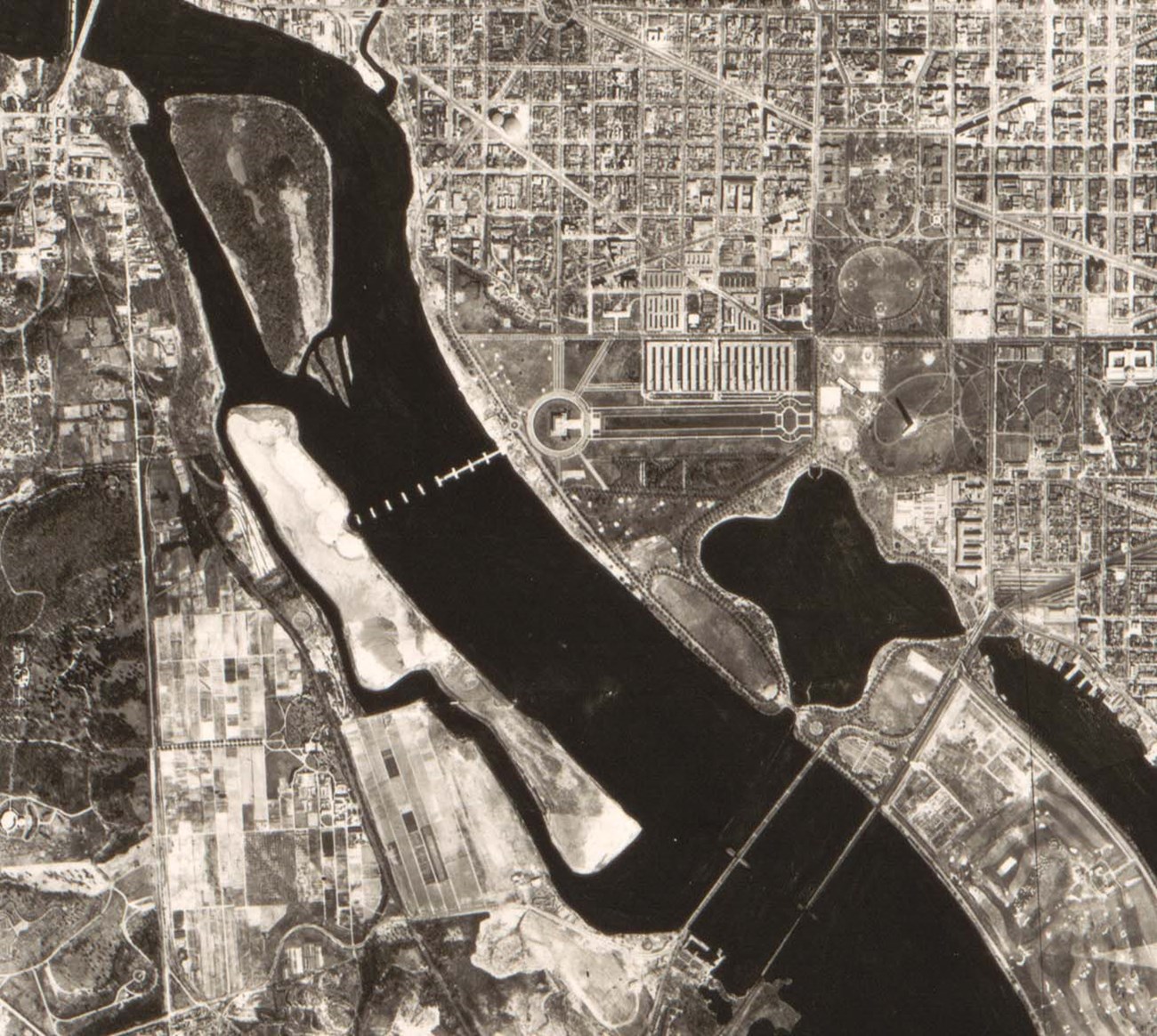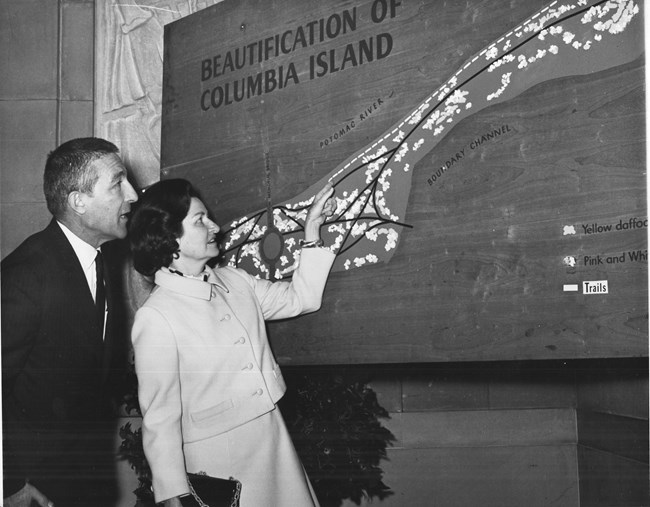Last updated: March 25, 2024
Article
LBJ Memorial Grove on the Potomac Cultural Landscape

NPS (2020)
Short Summary
The Lyndon Baines Johnson (LBJ) Memorial Grove on the Potomac is a designed landscape located in Lady Bird Johnson Park on the west side of the Potomac River in Washington, D.C. Lyndon Johnson served as the 36th president of the United States from November 1963 to January 1969. Johnson died on January 22, 1973. Claudia “Lady Bird” Johnson, his widow, began a campaign shortly thereafter to build a memorial in Washington, D.C. to commemorate the late president and gained Congressional approval for the LBJ Memorial Grove in December 1973.
The memorial was designed by M. Mead Palmer, a noted landscape architect, and constructed between 1974 and 1977. Harold Vogel was selected to carve the now iconic megalith at the center of the LBJ Memorial Grove plaza. Today the site serves as a memorial to President Johnson as well as a place of recreation where visitors can walk the trails, picnic, and take in views of Washington, D.C.

NPS (2021)
Landscape Overview
The Lyndon Baines Johnson (LBJ) Memorial Grove on the Potomac comprises 31-acres and is dedicated to the 36th president of the United States. It is located on the southern end of Lady Bird Johnson Park and bordered on the east by the George Washington Memorial Parkway (GWMP) and on the south by the Columbia Island Marina. The LBJ Memorial Grove was conceived by Brooke Astor, Laurance Rockefeller, Mary Lasker, and Nash Castro, who approached Claudia “Lady Bird” Johnson with the idea shortly after her husband’s funeral. Astor was a family friend of the Johnsons, Rockefeller and Lasker were former members of the Beautification Program, and Castro was the former Regional Director of National Capital Parks who had helped implement Beautification Program projects. Lady Bird Johnson and her supporters formed the Committee for a Lyndon Baines Johnson Memorial Grove on the Potomac by February 1973 to oversee the planning, fundraising, and construction of a memorial.
M. Meade Palmer designed the LBJ Memorial Grove as a living memorial, a type of commemoriative memorial that gained popularity following World War I that also intended to serve a civic function. The term “living memorial” applies to the commemorative space, opportunities for passive recreation, and also the pine tree grove and other plantings that physically define the space. A memorial plaza serves as the commemorative space for President Johnson with a 19-foot-tall 43-ton granite megalith as its focal point. From the plaza visitors are offered unobstructed views of Washington, D.C. and the monuments on the National Mall, a key component of the original design. To the north of the plaza the meadow serves as a recreational space with pathways, benches, and picnic tables. There are two entrances to the memorial, one located at the north end of the Columbia Island Marina parking lot, and one located in Virginia on the Pentagon Reservation. This latter parking lot was envisioned as the main entrance to the memorial and leads to a pedestrian bridge over Boundary Channel that connects the island to the mainland.

“Photographic Mosaic Map, Washington, D.C.,” 1928. Library of Congress.
Landscape History Summary
Lady Bird Johnson Park began as a sandbar at the southern end of Analostan Island (also known as Mason’s Island), now Theodore Roosevelt Island, in the early 19th century. The U.S. Army Corps of Engineers (USACE) created a new island on top of the sandbar with dikes and levees between 1915 and 1927. The newly formed land was officially named Columbia Island in 1920 and a small waterway that had been left to separate the island from mainland Virginia was named Boundary Channel. Volunteer vegetation, such as trees, also began springing up along the shoreline.

“Lady Bird Johnson with Park Plan Sign A,” 1968. NPS / NCR Museum Resources Center (MRCE)
Construction for the Mount Vernon Memorial Highway (MVMH), which would link the former Mount Vernon plantation with Washington, D.C., began in 1929 and was completed in 1932. This highway was absorbed into plans for the George Washington Memorial Parkway (GWMP) in 1930 under the Capper-Cramton Act. Most of this roadway was constructed between 1935 and 1965, with the NPS completing the final section in 1970. Although planting recommendations for the island were developed in the 1930s by landscape architects James L. Greenleaf and Gilmore Clarke, their plans were never fully implemented. The Columbia Island Marina was designed by Horace W. Peaslee in 1955 and built between 1956 and 1965 at the southern tip of Columbia Island.
Lyndon Johnson became president in November 1963 following the assassination of John F. Kennedy. Lady Bird Johnson, now first lady, made herself into an integral part of the Johnson administration’s work on improving the urban environment through her involvement in its Task Force on Natural Beauty in 1964. Lady Bird Johnson formed the First Lady’s Committee for a More Beautiful National Capital in February 1965 to transform Washington, D.C. into a “garden city.” That same year, Lady Bird Johnson helped to form a non-profit, the Society for a More Beautiful National Capital, which operated until 1972. Lady Bird Johnson’s Beautification programs transformed the city with clean-up projects, new floral displays, and the installation of amenities such as playground equipment, benches, and trash receptacles. In the summer of 1967, the Beautification Program hired Edward Durell Stone, Jr. to create a master planting plan for the island. Over a million daffodils were planted through the rest of the 1960s as well as thousands of trees. In appreciation of Lady Bird Johnson’s beautification efforts, Columbia Island was officially renamed Lady Bird Johnson Park on November 12, 1968.
Beautification
A Legacy of Lady Bird JohnsonLyndon Johnson declined to run for office in 1968 and died five years later on January 22, 1973. Brooke Aster, Nash Castro, Laurance Rockefeller, and members of the Beautification Program approached Lady Bird Johnson shortly after the funeral and proposed the idea of a memorial grove to commemorate the late president. The Committee for a Lyndon Baines Johnson Memorial Grove on the Potomac was organized by that February and had selected a landscape architect, M. Meade Palmer. Palmer and the Committee selected a location in Lady Bird Johnson Park for the memorial grove in April 1973 and a conceptual design had been approved by both the US Commission of Fine Arts (CFA) and the National Capital Planning Commission (NCPC) in September 1973. This design included a meadow, an elevated plaza with a megalith at its center, and a pedestrian bridge over the Boundary Channel. Congress authorized the memorial’s construction in December 1973.
A groundbreaking ceremony was held on September 27, 1974. The memorial grove was built in two phases. Phase I involved planting the grove of white pines and shrubs, sculpting and placing the megalith, installing benches, lighting, trash receptacles, and a secondary entrance at the Columbia Island marina. The megalith was to be shaped from a 19-foot-tall 43-ton chunk of “Sunset Red” granite, a rock local to the area around the Johnsons’ ranch in Texas, and Harold Vogel, a noted sculptor, was selected to carve the monument in the summer of 1975. The finished megalith was moved to its final location on August 13, 1975. Phase II involved building a pedestrian bridge over Boundary Channel and a parking lot on the Pentagon Reservation on the Virginia shore to serve as the main entrance to the memorial grove.

NPS (2020)
Palmer was well known for working with the topography of a location when designing the landscape. He used minimal grading to elevate the megalith plaza and create an unobstructed view over the GWMP to the Potomac River and the district’s memorial core beyond. In the meadow, Palmer created small berms to block the view of traffic to the north and east creating a bowl shape within the center of the meadow. Palmer also incorporated many of the existing trees and plants that had grown on the island since its creation and from earlier designers’ plans. Palmer originally intended for white pines and loblolly pines to make up the memorial grove, but Lady Bird Johnson requested that only white pines be used. The finished grove had about 900 white pines with about 700 concentrated around the memorial plaza.
The Lyndon Baines Johnson Memorial Grove on the Potomac was officially dedicated on April 6, 1976. After the completion of the Pentagon entrance and pedestrian bridge in mid-1977 a final dedication ceremony was held on October 12, 1977. The Texas State Society began holding an annual wreath laying ceremony on Johnson’s birthday, August 27, in 1981 that has continued to the present day.
Between 2000 and 2003 John Milner Associates, Inc. developed and implemented a rehabilitation plan for LBJ Memorial Grove. This plan included treatments for the flagstone walkway, stone retaining wall on the Virginia side, and the pedestrian bridge and deck as well as improving access and amenities for visitors with disabilities.

NPS (2020)
Existing Conditions
The LBJ Memorial Grove is a vibrant landscape. Visitors may enter the grove through two entrances, one over the Boundary Channel from the Virginia side and one in Lady Bird Johnson Park in Washington, DC. From either entrance, a spiraling flagstone walkway leads the visitor to the memorial’s plaza where the megalith stands. Visitors are treated to spectacular views of Washington, D.C. from the plaza and can also read about LBJ from an interpretive wayside and granite panels etched with quotations that illustrate the goals of his administration. To the north of the plaza visitors can stroll along asphalt paths that loop around a grassy meadow. On the 4th of July many spectators use the grounds to watch the fireworks display above the city.
The grove appears much the same today as it did when first constructed in the mid-1970s. Hundreds of white pines shade carefully laid out walkways, while flowering shrubs and groundcover grow in tended beds. Drifts of daffodils alongside the George Washington Memorial Parkway fill the lawn areas with yellow blooms each spring. The Boundary Channel provides opportunities to watch wildlife such as turtles, fish, and birds. The most noticeable change within the grove is in its understory plantings, some of which have been changed to varieties that are easier to maintain. However, the LBJ Memorial Grove is still an excellent place for visitors to walk, picnic, and contemplate President Johnson’s legacy just as M. Meade Palmer had intended.
Vegetation at the LBJ Memorial Grove: 1983-2023


Left image
“Aerial Photographic Map of Arlington County, Virginia,” 1983
Credit: Arlington County, Virginia Maps
Right image
2023 satellite image of the LBJ Memorial Grove
Credit: Google Earth
Quick Facts
-
Cultural Landscape Type: Designed
-
National Register Significance Level: National
-
National Register Criteria: A, C
-
A (National/Local) as a presidential memorial at a national level of significance
-
C (National) as an example of 20th Century landscape architecture
-
-
National Register Criteria Considerations
-
Criteria Consideration F: Commemorative Properties
-
Criteria Consideration G: Properties That Have Achieved Significance Within the Last Fifty Years
-
-
Period of Significance: 1974-1977
-
1974 – the year former First Lady Claudia “Lady Bird” Johnson and President Gerald Ford led a ceremonial groundbreaking at the site and planted the first of the white pines (Pinus strobus) at the memorial grove,
-
1977 – when the National Park Service completed construction of the entrance on the Pentagon Reservation including the Palmer-designed pedestrian bridge across Boundary Channel
-
